The setup: SCAR-17S in 7.62×51 / .308 with GRSC Combat Rifle Scope. Shots fired at 100yards off a swivel bipod / grip pod canted slightly left. Ammo: 145 gr mil surplus FMJ. No sandbags or other stabilizing devices used. These were free hand shots.
First off: On this particular target, we have what is, for me, the clearest indication of an actual 100 yard head shot. And that’s because the target uses for its graphic a life-size head representation (about 10.5″) — which is in keeping with the specific design of the combat reticle on the GRSC scope (the horse shoe that frames the aim point represents the 10″ average head size at each of its target distances, along with, through dashes at longer ranges, the 20″ span of the average shoulders). Within that head area, I marked off the 4x4x2.5″ T-box to represent the non-flinch medulla oblongata kill zone. For these shots, I used no illumination on the reticle. I pulled one shot slightly left, but it still made the target area.
I also aimed for a 4.5 x 4.5″ area of the shoulder, as well a smaller 3×3″ chest/heart shot, and the gun hand. The hardest shot for me in this drill was the heart shot, because at 100 yards and 6x magnification I couldn’t quite make out the outline of the box I’d drawn. I plan on buying some thick, brightly colored masking tape to solve this problem in the future. Still, you can see where the shots hit based on my estimation of where the box likely was. On these shots, I illuminated the reticle.
The next drill simulates shots taken at around 200-220 yards (based on the size of the head in the graphic). At that range, head shots are more difficult, obviously, particularly when you’re still going for the T-box. Not to make excuses, but again, seeing the box at that distance was very difficult, and the head blended in with the background buildings. Still, I was able to put 3/5 into the T-box, with one miss each to the left and to the right. Missing to the right, however, meant a hit to the neck, because of the cocked angle of the head. In truth, I think had I aimed at the forehead rather than trying for the medulla shot, I’d have hit the head on all 5 shots. But there’s no harm in training to be as precise as possible.
I then went after the heart. I couldn’t see the box, but I could make-out the tattoo and the medallion, and based my shots on those locations. I had a very nice five shot grouping.
The stomach shots you see were rapid fire and a couple of them missed the mark. But to be honest, I was finishing off a magazine and was just looking to hit the torso lower than the heart. I hit 3/5 in the box with the other two in the lower abdomen.
Drill 3 used a mostly life-sized head (about 9″) and added an obstruction: the shotgun being pointed at my shooting position. The key here was to view the shotgun as part of the T-box and shoot at it that way. The trapezoid measured about 3.5 x 3.5 x 3.25″ x 1.75″. Out of the 11 shots I took, 10 hit inside the T-box, with one slightly low, hitting the thumb of the shotgun support hand. I also hit both eyes, which is kinda freaky — especially when the target is traveling back to you and you can see the holes for the first time.
Drill 4 was also very difficult: the head size on the graphic suggests an approximate real shot distance of about 200 yards, with the head in partial profile. And as you can see in the picture, I wasn’t able to see parts of the T-box, either because of the hat obstruction of the angle of the head. Consequently, and much to my sorrow, I ended up shooting a civilian standing behind the shooter. Then again, with .308 FMJ, with over penetration I might have hit him anyway even on the three shots where I was able to hit the T-box. For a 2.5″ x 2″ x 1.5″ target, I’m encouraged by 3/5, particularly with the grouping of the hits: those 3 shots were within an inch, and two of them were within less than 1/2″. But I won’t be happy until I put all five shots on target.
I also aimed at a 2.5″ x 3.5″ area under the armpit, which I figured would act as a lung and heart shot. I was able to put all five shots on target. Below that is a stomach/side shot. Those were rapid fire shots, and while the grouping isn’t as precise as some of the more deliberate shots, I still put them in the box. So that’s a nice sign of competency.
I also took a half hour yesterday to do some pistol range shooting, with both my FNP 45 Tac and my Taurus 24/7 OSS Tac in .45 acp. These were rapid fire drills, emptying mags at 7 yards and then 10 yards. How the graphic size would equate to a recalibration of the distance, based on the size of the head and torso, I’m not sure, though I’m tempted to guess it nearly doubles it in effect (if anyone knows, please tell me). I set the pistols up to be cocked and locked with one extra already chambered, so the FNP fires 16 from a single magazine (15 + 1) and the Taurus 13. On one of the Taurus mags, though, I was a cartridge or two short.
I aimed for the head, the heart, and the stomach, with one special shot that I saved for last. The guy in the lane next to me, who I didn’t know was watching, got a real kick out of that final shot, too. “He had it coming,” I told him.
I had no misses at 7 yards and 1 at 10 yards. Not sure if the miss was with the FNP or the Taurus. The FNP has a Trijicon RMR amber holographic dot reflex site (4 MOA); the Taurus I use just the iron sights.
Here’s another 7 and 10 yard drill with both pistols. This, because of the life-size head and the situation being simulated, was particularly good for a rapid-fire pistol drill. I aimed mostly at the head and chest, with a few shots taken at the gun hand. I’m happy to say I was on target and would have done some serious damage with my home defense pistol, the FNP 45 ACP, which I keep loaded, when at home, with premium hollow point defense ammo in +p.
Finally, just to be comprehensive, here’s the first target I shot on the rifle range yesterday, making sure I had the GRSC rifle scope perfectly zeroed in at 100 yards. You can see the adjustments being made — I started left and a bit high, overcompensated in the adjustment and went low right — until I finally put the last 6 shots within the 1″ zone, including two on the bull’s eye. The final 4 shot grouping was about 1″ – 1.5″, again, shooting free hand off the swivel bipod.
So, there you go.
The way I look at it, any of these armed assailants might turn into zombies — and particularly nasty ones, too — once the global outbreak hits. So I may as well put them down now.
Consider it an act of charity or mercy. Or don’t, and just assume I’m a sociopath. Either way, the results are the same. Which is kinda cool.

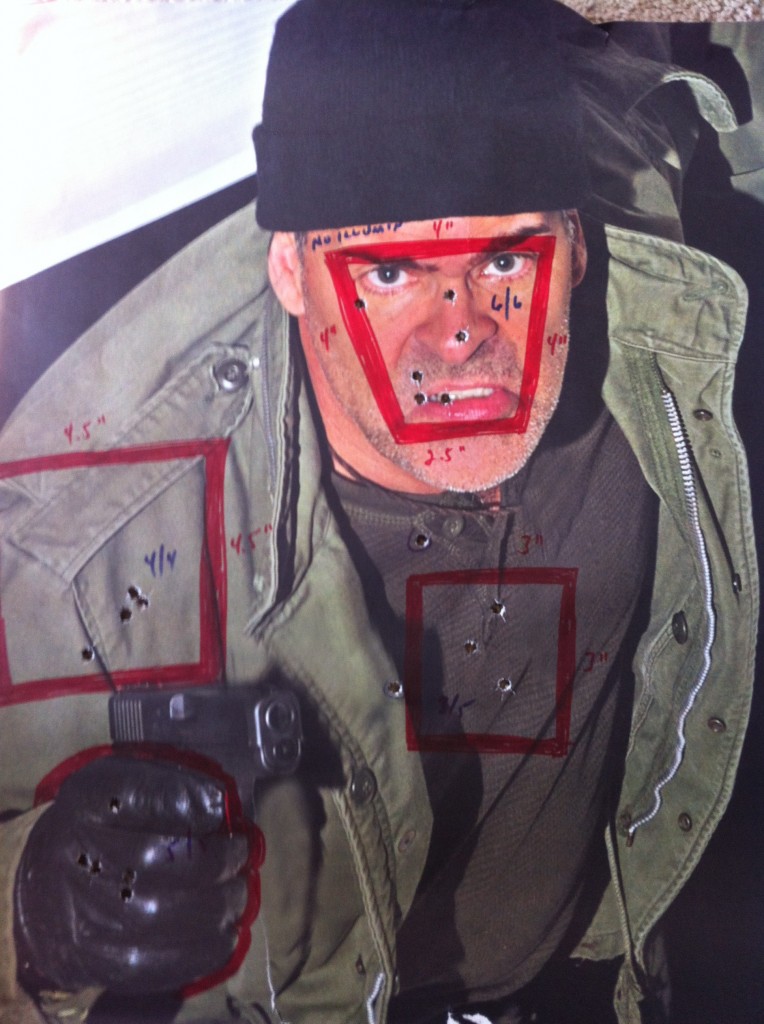
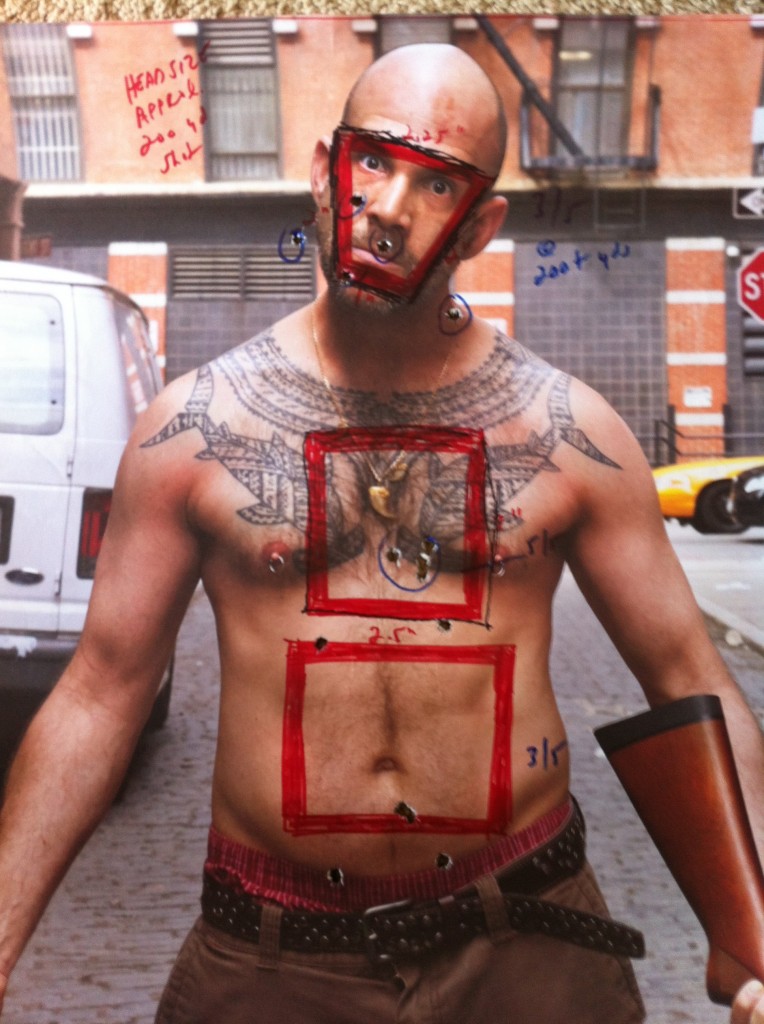
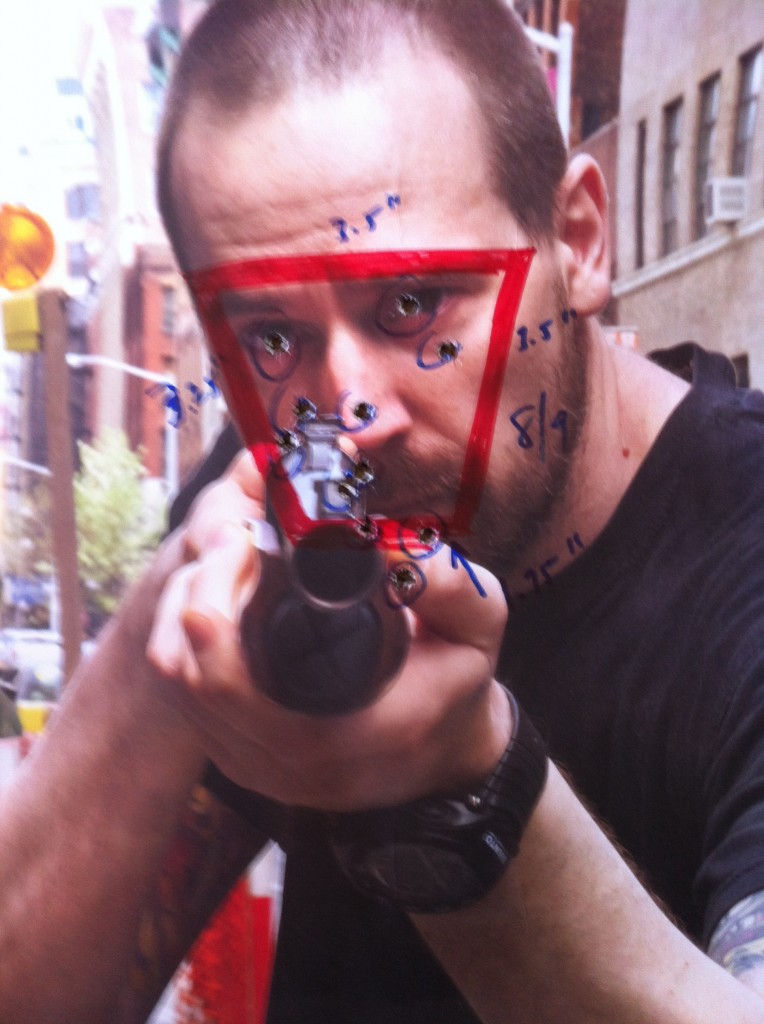
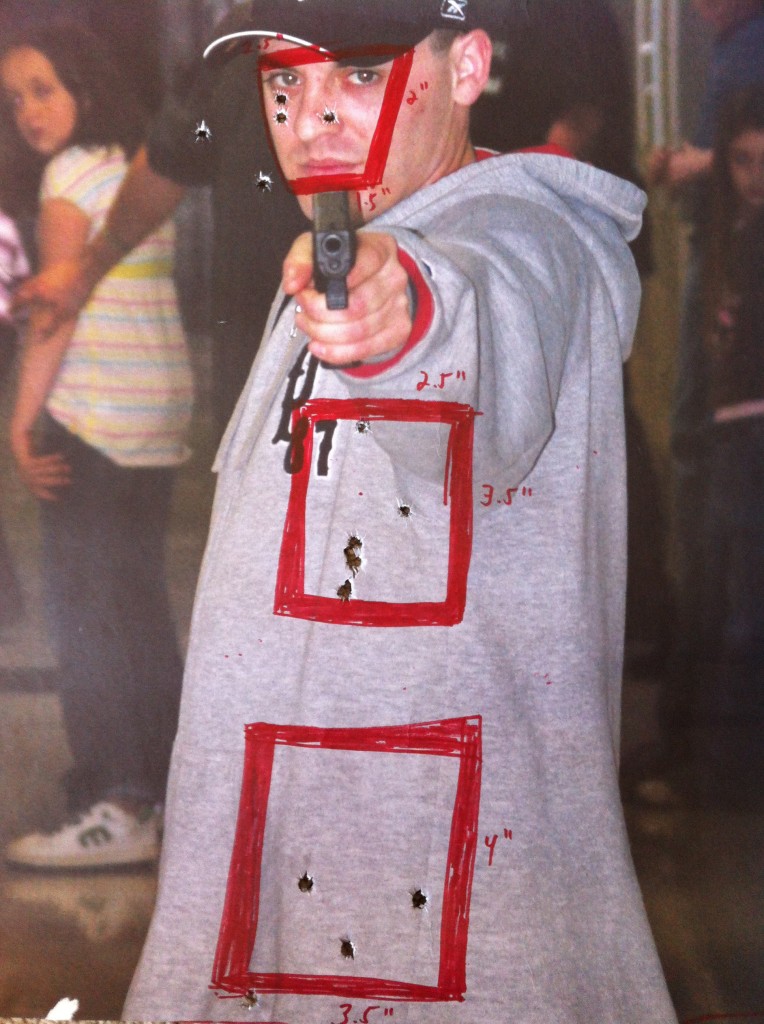
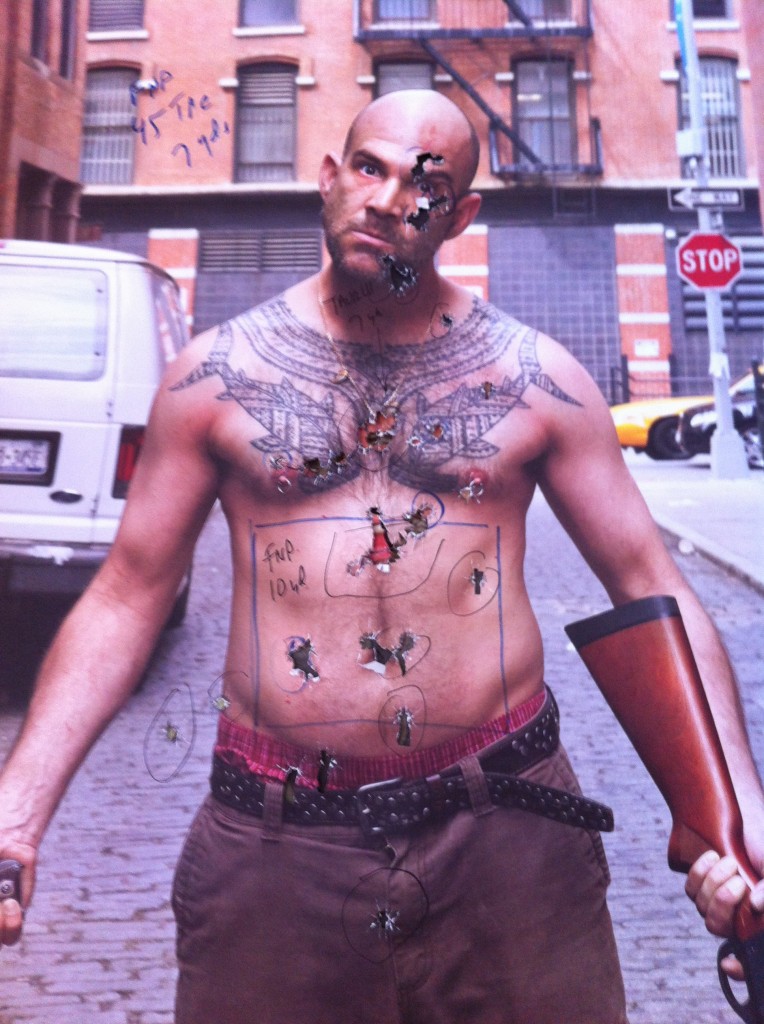
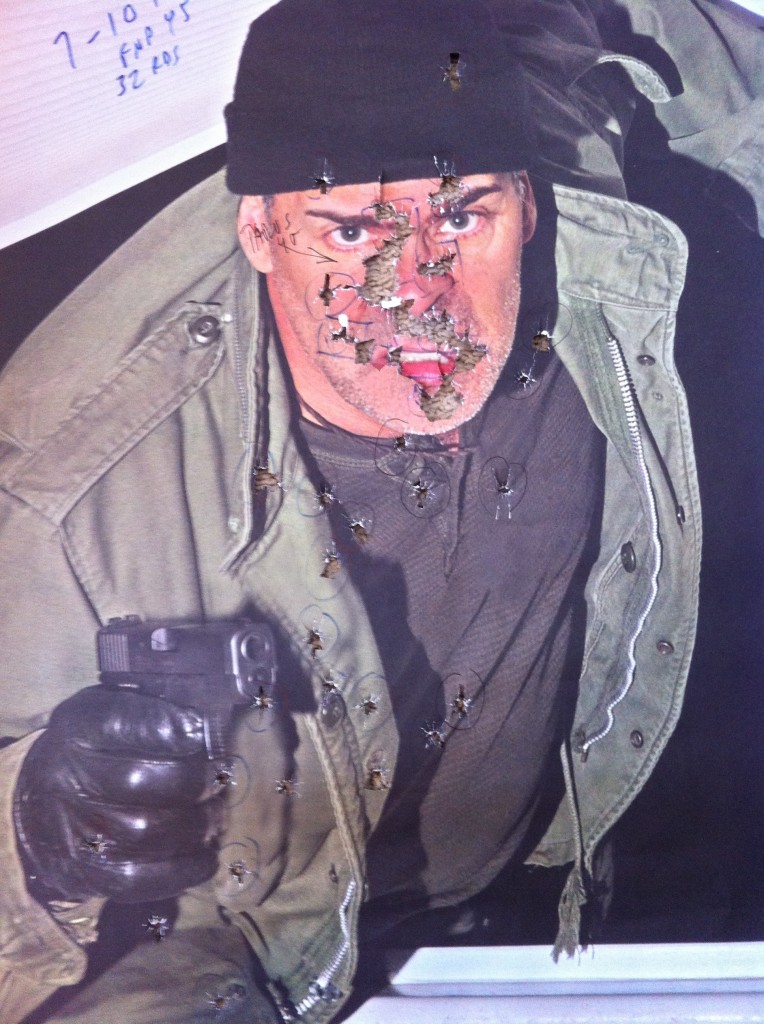
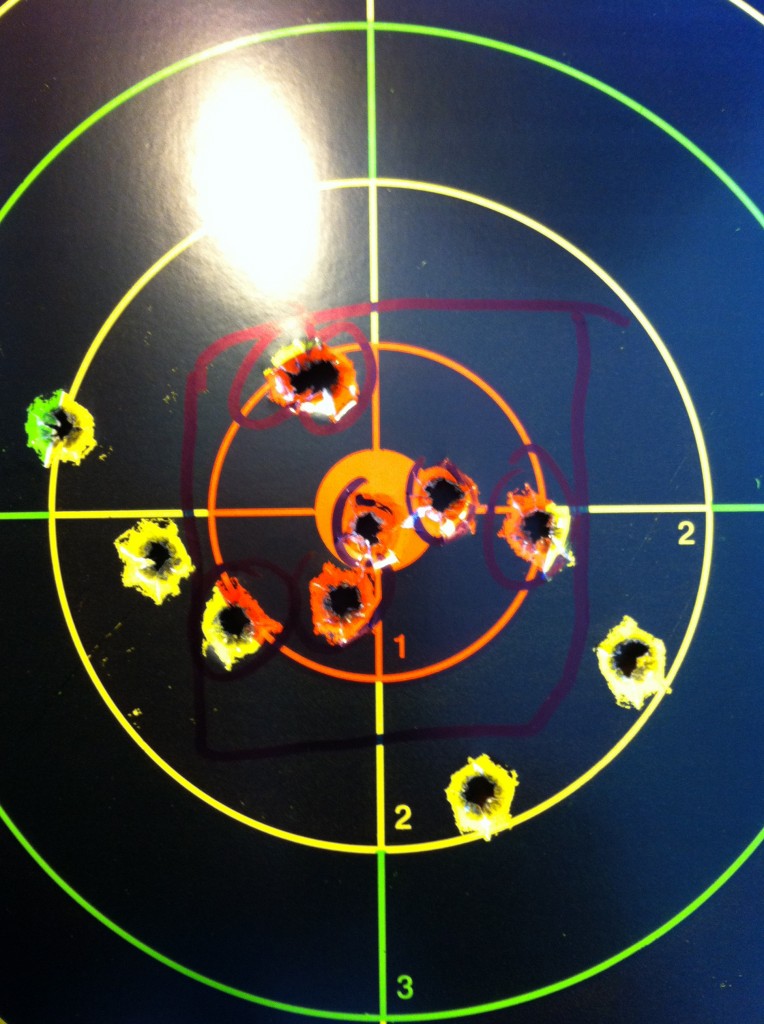
[…] promised Here are a few follow-up results. Some of the shots taken, because of the size of the head in the graphic, approximate a 200-220 […]
You sure jellied gray hoodie/black ball-cap’s liver!
How long before the Obama campaign puts out target blow-up pictures of Nakoula Bassely Nakoula’s face? C’mon OFA, y’idiots, yer slackin’!
Or just some generic white guy with a Romney button and the legend “rich racist douche who doesn’t want you to take his stuff and make it yours, which is your right.”
Those would sell HUGE. If any leftists owned guns, I mean.
heh
You should get some targets of jihadis.
Jeff, really nice to see that you can shoot “minute of bad guy” offhand without sandbags.
Preparing yourself for taking on zombies with kill zones outlined in brightly colored masking tape?
Any gun is better than no gun — the First Law of Gunfighting is “have a gun” — and any practice is better than no practice at all, so I don’t want to discourage you, far from it! But you’re discovering one of the big problems of real world shooting — that the aim point is usually not well defined — and attempting to solve that problem with brightly colored masking tape.
What will you do when you meet a real world zombie ill-adorned in brightly colored masking tape? I really don’t want to be the wet blanket here, and I’m glad that you’ve armed yourself(!) But what are you thinking?
Generally speaking, it’s hard to go wrong by shooting center of visible mass.
I’m thinking that the masking tape identifying the region for me now will allow me to become good at recognizing exactly where it is when no tape is around it simply by force of repetition.
It’s not as if I aim simply at the taped box. I use it to locate it in comparison to other parts of the target I’m able to identify more clearly. Several times here I mentioned that when I can’t see exactly I approximate based on anatomy points. I figure I’ll have a clearer idea of how much I need to move up or down or side to side if I train in clearly identified zones.
Does that not make sense? Because it does to me, but I’m not expert.
Of course. And especially with .308. But there’s nothing wrong with becoming a better shot, is there?
I feel like I’m doing something wrong. Lots of comments seem to be that I’m too worried about perfecting my aim. Whereas I don’t see where it hurts. But again, I’m no expert.
Heh. Well, for now. So long as they stand still.
You aren’t doing anything wrong. Need to lose those training wheels soon though…
I have a question, when you say “off a swivel bipod / grip pod canted slightly left”, does that mean you are using a rest, or free standing?
depends on what you mean by a “rest,” Lee. I’m shooting off a deck, but that just means I’m shooting off a flat surface. The bipod is a pistol grip that when clicked divides in two legs and extends out into a bipod. It swivels and cants, so it’s not a completely stable bipod, but it’s good for shooting off uneven surfaces, as each leg can be set independently for height.
And I’m not sure what “training wheels” I need to lose. At this point, if I had a 8-12x scope, I’m pretty sure at 100 yards I could hit a dime. The reason I chose the scope I’m training with, as I explained a long while back, is that it’s a 90% solution 100% of the time. It is designed, first and foremost, as a CQB scope. But it has an effective range out to 600+ yards. That takes care of most situations. I’m not shooting a sniper rifle, I’m shooting a battle rifle. But I’m training with a battle rifle, with a stock trigger and ball ammo, as if I were a sniper. That’s to perfect my aim, my breathing, and my trigger pull.
I can hit my target generically every time. I’m working on perfecting my aim. That is, I’m hitting much smaller targets within the target, with mil surplus ammo.
A beer can at 100 yards is going to be roughly a 6″x 3.5″ target. That to me now is a shot I’d hit 98 out of 100 times. If you look at some of my “training wheel” shots, I’m hitting a 3″ x 1.5″ target at the effective equivalent of 200 yards. With a scope that maxes out at 6x magnification.
I may not have been shooting all my life, but I’m shooting a lot now, and I’ve gotten pretty proficient with this rifle in these conditions. Naturally, I’ll extend my training — doing outdoor and movement work with a SF buddy of mine — but I think it’s a bit unfair to label the attempt to identify the target I’m shooting at “training wheels.” Me, I look at it this way: if I can see it, or approximate it, I can hit it. At least out to 220 yards.
Generally and perhaps inaccurately speaking, to the best of my layman’s knowledge, battle rifles don’t come equipped with bipods, while sniper rifles do.
Back in my Boy Scout days, when I was still shooting because I didn’t know any better, we shot from standing (offhand), kneeling, and prone positions. How are you at those?
Nothing wrong with shooting from a rest of some kind. It’s almost required for long shots (we can’t all be as good as Serr8d). But it’s not the only way to shoot.
The bipod is also a forward grip when not deployed as a bipod.
Today I’ll shoot some standing.
Good shooting.
“Training wheels” may not have been apt, I’m master of the bad analogy. That one was in reference to what Swen was saying. And a rest is defined as a support for the rifle. Car hood, branch of a tree, a fence post, a bipod, all are shooting from a rest.
My concern (constructive criticism) is that you are caught up in the mechanics and might be missing the art. (warning: bad analogy alert!) Like a guy with a guitar learning all the chords but not playing music. Or a guy constantly attempting to make straight cuts with a saw, but not building anything.
No offense, I do not intend to belittle what you’re doing. Just the opposite in fact. Just trying to impress on you(warning: bad analogy alert!) there is a whole world of shooting beyond the classroom of the range.
Jeff, you said your scope has a red light, yes? I just read something that said a green light is more ccurate/easier to see in different light situations. What do you think?
Also, have you read any of Gavin de Becker’s books? “The Gift of Fear” is a great one that explains how our ‘sixth sense’ let’s us know there is danger present before it becomes a conscious thought.
Umm, only think for a moment about ballet dancers in the practice studio, taking positions, turning, balancing, bending, leaping, repeating each of these elements of their art with intense attention to the smallest details, mere mechanics! — and all without dancing a ballet. Or the pianist, meticulously toiling away at scales and arpeggios, or two measure fingering exercises, again, repeating these over and over with fearsome exactitude until they’ve become — so we say — second nature, all without committing to the keyboard the first interpretation of a Bach Invention. Or take the welder, running bead after bead on flat sheet, honing his technique to a fare-thee-well, since running that bead in order to master his hand and eye for the first time inside a nuclear reactor under construction just isn’t cool (unless he’s really enamored of grinding away rejected welds). The bowler. The pitcher. The golfer. The place kicker. Excruciating attention to the physical mechanics of our practice has its place in every art — at least for all who don’t enter the world freakish savants, and even for them has a place, though it be less prominent. Master the simple, mechanical, habitual and repetitive stuff to thereby free oneself to explore the outlying (and possibly creative) spaces thereafter.
Whatever Sdferr. You know it, I’ll stow it. Carry on.
Actually, golf might be another bad analogy I could use. You can spend a year at the driving range hitting your driver off a tee, and it will be good practice. Totally different from when you get on the course and deal with different distances and different lie’s though. There’s a finesse involved that only practicing with the big stick off a tee won’t help with.
NOW, since I’m obviously a downer, I’ll stow it.
Hey, don’t take offense, cause I dunno. I can recall however, among other instances of technique practice, hand-cutting dovetail joint after dovetail joint into scraps — dozens of ’em — before I attempted to slice into that sweet-assed and unique piece of blackcherry drawer-front. I figured, I’ve got the time and the scraps: why risk it?
You might want to search out some competitive action-shooting events that are popping up all over. As you can see in the video, those steel targets give nice feedback when knocked down.
I ran a combat pistol match back in the early ’90’s that featured timed trials, moving targets that had must-accomplish tasks, or you’d lose points (seconds) if you failed to do the course correctly. For instance, a ‘key drop’, where one had to pick up a key from behind a wall, or drop a key at a certain stage and at a certain junc-ture. These requirements simulated random happenstances that normally don’t happen on a placid shooting range. And keeps one ‘out there’ and shooting, what one must do to keep a sharp edge.
Those are fun, serr8d. It’s been about 10 years since I did that.
That was cool serr8d. I always wanted to do a course like Dirty Harry in Magnum Force, but never have.
Maybe I outta build one. I’m an underemployed California construction worker, living in the hills…
What do ya think fellas, $50 a ride?
Free if you match the course high score. $50 prize if you break it.
Ahhh, here’s the Colorado 3-gun and practical shooting linky. Gotta be some good info there that’ll help you make contacts.
Build it, Lee, they will come. And shoot your wooden frames to smithereens!
What used to be fun, fun, fun was ‘bowling pin‘ matches. Sit up bowling pins and knock ’em down. The .45 ACP excelled at that; little 9mm, not so much.
But that’s gone it seems. Haven’t heard of one in over a decade.
I plan on doing all of those kinds of things, but for now, what I have available to me in my gun club, and what I have available are 25 yard ranges and 25-100 yard ranges. The club does run competitive shooting leagues, but I’m not nearly there yet.
I shot yesterday without any marks on the targets. If I have time later I’ll post the results. Shooting off a rest was much more difficult for me, so that’s what I’ll work on next. I suspect it’s going to take figuring out what the proper butt stock length is for me, what the best grip is (I tried with the bipod folded into a foregrip and with my hand out toward the end of the rail), and getting use to the heft of the weapon. I felt very shaky at 100 yards standing bold upright; holding the gun off the deck with my elbow using the foregrip folded I was able to hit a nice tight grouping. So it’s baby steps.
As for some of the other comments, remember, I haven’t been shooting for more than a couple months, and it wasn’t until last month that I fired a rifle for the first time (well, second time: I shot my buddy’s rifle a couple times at some bottles back in high school). I like the progress I’m making, because I take the practice seriously. Too, I understand that sitting in a stall shooting down range doesn’t replicate most real-world scenarios. But it’s also better than only getting to shoot every once in a while when I can find a place in the mountains.
The first time I shot the SCAR it was outdoors using reactive and paper targets. We were roughly 130-140 yards out. I hadn’t yet learned to use the scope as I do now; and I didn’t know how to range distance. Thanks to a reader here, I now have a Bushnell laser range finder, which, in addition to giving me exact yardages, teaches me, through repetition, to guestimate the yardages without aid myself.
I like the reactive targets. with my FNP 45 at about 15 yards I knocked one completely off its base. That was kinda cool.
Still, the gun club is about a 10 minute drive; to get up into the mountains on public land and find a shooting spot is more like a 90 minute drive. I have a SF buddy looking to acquire some land close to us to set up a zombie apocalypse training course. It will teach basic survival, practical rifle and pistol use, and so on — including negotiating around corners, getting in and out of automobiles, how to use steel wool to start a vehicle, and other cool, practical shit.
Until then, though, perfecting technique, breathing, trigger pull, aim, and speed of reaquiring the target seems not like a waste of my time, but rather useful. Each day I shoot I become more and more comfortable with my weapons. And that’s a good thing.
Americana: “We’re a culture, not a costume.“
I admire your dedication, Jeff. Practice makes perfect, after all.